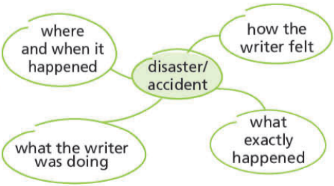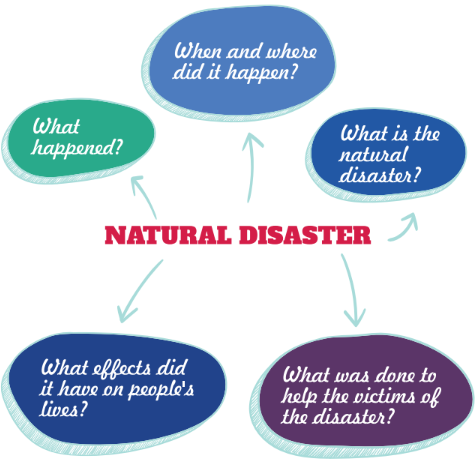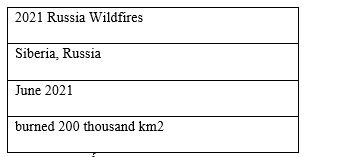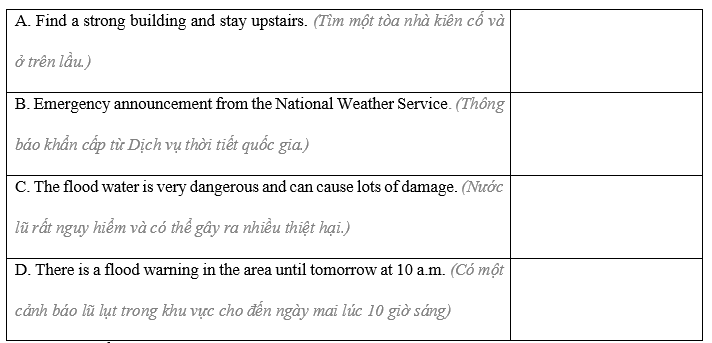Writing
(A story about a natural disaster/ an accident)
Task analysis (Phân tích bài tập)
1. Read the task and complete the table.
(Đọc bài tập và hoàn thành bảng.)
|
An international teen magazine wants its readers to send in a story about a natural disaster or an accident they experienced. Write a story for the magazine (about 80-100 words). Include when and where it happened, what you were doing, what exactly happened and how you felt. (Một tạp chí quốc tế dành cho thanh thiếu niên muốn độc giả của mình gửi đến một câu chuyện về một thảm họa thiên nhiên hoặc một tai nạn mà họ đã trải qua. Viết một câu chuyện cho tạp chí (khoảng 80-100 từ). Bao gồm thời gian và địa điểm xảy ra, bạn đang làm gì, chính xác điều gì đã xảy ra và bạn cảm thấy thế nào.) |
|
Type of text |
|
|
Readers |
|
|
Topic |
|
|
Number of words |
|
|
What to include |
|
|
Type of text (Loại văn bản) |
Paragraph (Đoạn văn) |
|
Readers (Đọc giả) |
Teenagers (Thanh thiếu niên 13 – 19 tuổi) |
|
Topic (Chủ đề) |
A story about a natural disaster or an accident readers experienced (Một câu chuyện về thiên tai hoặc tai nạn và người đọc đã trải nghiệm) |
|
Number of words (Số lượng từ) |
80 - 100 words (80 – 100 từ) |
|
What to include (Bao gồm những gì) |
When and where it happened, what you were doing, what exactly happened and how you felt. (Nó đã xảy ra ở đâu và khi nào, lúc đó bạn đang làm gì, chính xác chuyện gì đã xảy ra và bạn cảm thấy như thế nào.) |

Các bài tập cùng chuyên đề
4. Work in pairs. Discuss what you should do before, during and after a flood. Write your ideas in the columns.
(Làm việc theo cặp. Thảo luận về những gì bạn nên làm trước, trong và sau lũ lụt. Viết ý tưởng của bạn trong các cột.)

5. Write instructions (80 - 100 words) about things to do before, during, and after a flood.
(Viết hướng dẫn (80 - 100 từ) về những việc cần làm trước, trong và sau lũ lụt)
Start as follows:
Here a things you should do before, during and after a flood.
Before:
-
-
During:
-
-
After:
-
-
a. Read about writing emergency announcements, then read the flood warning again. Circle and number (1-4) the four parts of the announcement noted in the Writing Skill box.
(Đọc về viết thông báo khẩn cấp, sau đó đọc lại cảnh báo lũ lụt. Khoanh tròn và đánh số (1-4) bốn phần của thông báo được ghi trong ô Kỹ năng Viết.)
|
Writing Skill (Kĩ năng viết) Writing emergency announcements (Viết thông báo khẩn cấp) A good emergency announcement should include four main parts: (Một thông báo khẩn cấp tốt nên bao gồm bốn phần chính) 1. Heading - Note the emergency type, who is sending the announcement, and when. (Tiêu đề - Lưu ý loại khẩn cấp, ai đang gửi thông báo và khi nào.) 2. What/Where/When notes - Keep these short and simple. (Ghi chú Cái gì/Ở đâu/Khi nào - Giữ những ghi chú này ngắn gọn và đơn giản.) 3. Summary - Briefly note the cause and main dangers. (Tổng kết - Ghi vắn tắt nguyên nhân và những nguy hiểm chính.) 4. Instructions - Note what people should do as point form notes. (Hướng dẫn - Lưu ý mọi người những việc cần làm như ghi chú dạng điểm.) |
b. Number the sentences (1-4) to match them with the parts of an emergency announcement. Use the Reading and Writing Skill box to help you.
(Đánh số các câu (1-4) sao cho phù hợp với các phần của thông báo khẩn cấp. Sử dụng hộp Kỹ năng Đọc và Viết để giúp bạn.)
A. We expect damage to buildings and houses along West Becch.
B. What: Tsunami, Where: Baytown City, When: 07:37 May 3 to 09:30 May 3
C. The wave could be as high as four meters when it hits West Beach.
D. Tsunami warning from the Pacific Ocean Service, Sent: 06:31 May 3
E. Move to higher ground far from the sea immediately.
F. A large undersea earthquake started a tsunami.
Now, write an emergency announcement warning another town about the disaster you discussed in Speaking. Use the Writing Skill box and your speaking notes to help you. Write 80 to 100 words.
(Bây giờ, hãy viết một thông báo khẩn cấp cảnh báo một thị trấn khác về thảm họa mà bạn đã thảo luận trong phần Nói. Sử dụng hộp Kỹ năng Viết và ghi chú nói của bạn để giúp bạn. Viết 80 đến 100 từ.)
Write an announcement about a disaster in the place where you live. Write 80 to 100 words.
(Viết một thông báo về một thảm họa ở nơi bạn sống. Viết 80 đến 100 từ.)
You are writing a guide about how to prepare for and what to do during a disaster. Choose a disaster, think of three pieces of advice and one reason for each. Complete the table.
(Bạn đang viết một hướng dẫn về cách chuẩn bị và những việc cần làm trong một thảm họa. Chọn một thảm họa, nghĩ ra ba lời khuyên và một lý do cho mỗi lời khuyên. Hoàn thành bảng.)
Now, use your notes to write a guide about how to prepare for and what to do during a disaster. Write 80 to 100 words.
(Bây giờ, hãy sử dụng các ghi chú của bạn để viết hướng dẫn về cách chuẩn bị và những việc cần làm trong một thảm họa. Viết 80 đến 100 từ.)
Model analysis (Phân tích mẫu)
2 Read the story. How did the writer set the scene? Underline the sentences in the text.
(Đọc câu truyện. Tác giả đã xây dựng bối cảnh như thế nào? Gạch chân dưới các câu trong văn bản.)
On Monday morning, I experienced a terrible fire in a building in West Street. I was walking to school with my friends when I saw smoke from the building. Then, the fire spread quickly. We ran down the street away from the fire. Soon, the fire fighters arrived and they put out the fire. The fire didn't injure or kill anyone, but it destroyed the building. I was terrified when it was happening, but I was relieved because everyone was safe.
3. Read the story again and complete the spidergram in your notebook.
(Đọc lại câu chuyện và hoàn thành biểu đồ lưới trong vở của em.)

4. Imagine you experienced a natural disaster or an accident. Write a story about it (about 80-100 words).
(Hãy tưởng tượng em đã trải qua một thảm họa thiên nhiên hoặc một tai nạn. Viết một câu chuyện về nó (khoảng 80-100 từ).)
Writing
9. Imagine you experienced the accident Exercise 6 on page 36. Listen to the interview again and take notes. Write a story about the accident (about 80-100 words). Include when and where it happened, what you were doing, what exactly happened and how you felt.
(Hãy tưởng tượng em đã trải qua vụ tai nạn Bài tập 6 trang 36. Hãy nghe lại cuộc phỏng vấn và ghi chép. Viết một câu chuyện về vụ tai nạn (khoảng 80-100 từ). Bao gồm thời gian và địa điểm xảy ra, em đang làm gì, chính xác điều gì đã xảy ra và em cảm thấy thế nào.)
3. Put the following ideas in the correct column. Some sentences can go into more than one place.
(Đặt những ý tưởng sau đây trong cột đúng. Một số câu có thể đi vào nhiều hơn một nơi.)
|
|
Earthquake |
Typhoon |
|
What happened? |
|
|
|
Where and when did it happen? |
|
|
|
What are the effects of this disaster? |
|
|
|
What have been done to help the victims of the disaster? |
|
|
1. Many people lost their homes.
(Nhiều người mất nhà cửa.)
2. Many people tried to cover their heads and hide under heavy furniture such as tables and beds.
(Nhiều người cố gắng che đầu và trốn dưới đồ nội thất nặng như bàn và giường.)
3. Rescue workers came to help local people.
(Nhân viên cứu hộ đến giúp đỡ người dân địa phương.)
4. Buildings in the epicentre area with weak walls experienced cracks and some houses collapsed.
(Các tòa nhà ở khu vực tâm chấn có tường yếu bị nứt và một số ngôi nhà bị sập.)
5. People could clearly feel a strong shaking.
(Mọi người có thể cảm nhận rõ ràng sự rung lắc mạnh.)
6. It hit the central Việt Nam as one of the biggest storms in the last two decades.
(Đổ bộ vào miền Trung Việt Nam là một trong những cơn bão lớn nhất trong hai thập kỷ qua.)
4. In groups, write a paragraph (80-100 words) to report a natural disaster you know well or have experienced yo your teachers and friends.
(Theo nhóm, viết một đoạn văn (80-100 từ) để báo cáo một thảm họa thiên nhiên mà bạn biết rõ hoặc đã trải qua với thầy cô và bạn bè của bạn.)
WRITING
5. Write a paragraph (80-100 words) to report a natural disaster in Việt Nam or a country you know. Use the clues below.
(Viết một đoạn văn (80-100 từ) để báo cáo về một thảm họa thiên nhiên ở Việt Nam hoặc một quốc gia mà bạn biết. Sử dụng các manh mối dưới đây.)

Look at the information below and the quick fact file above. Write a quick fact file about the 2021 Russia Wildfires.
(Xem thông tin bên dưới và tệp thông tin nhanh ở trên. Viết một hồ sơ thông tin nhanh về các vụ cháy rừng ở Nga năm 2021.)

Write one thing people should / shouldn’t do to prepare for and one thing people should / shouldn’t do during three different disasters. Use prepositions of place and movement.
(Viết một điều mọi người nên/không nên làm để chuẩn bị đối phó và một điều mọi người nên/không nên làm trong ba thảm họa khác nhau. Sử dụng giới từ chỉ địa điểm và chuyển động.)
Writing emergency announcements
A good emergency announcement should include four main parts:
1. Heading - Note the emergency type, who is sending the announcement,and when.
2. What / Where / When notes - Keep these short and simple.
3. Summary - Briefly note the cause and main dangers.
4. Instructions - Note what people should do as point form notes.
Tạm dịch:
Viết thông báo khẩn cấp
Một thông báo khẩn cấp tốt nên bao gồm bốn phần chính:
1. Tiêu đề - Lưu ý loại khẩn cấp, ai đang gửi thông báo và khi nào.
2. Ghi chú Cái gì / Ở đâu / Khi nào - Giữ những ghi chú này ngắn gọn và đơn giản.
3. Tổng kết - Ghi vắn tắt nguyên nhân và những nguy hiểm chính.
4. Hướng dẫn - Lưu ý mọi người những việc cần làm như ghi chú dạng điểm.
Number the sentences (1-4) to match them with the parts of an emergency announcement. Use the skill box to help you.
(Đánh số các câu (1-4) sao cho phù hợp với các phần của thông báo khẩn cấp. Sử dụng hộp kỹ năng để giúp bạn.)

Choose a disaster and make notes to write an emergency announcement about it.
(Chọn một thảm họa và ghi chú để viết một thông báo khẩn cấp về nó.)

Now, write an emergency announcement warning your town about the disaster. Use the Writing Skill box and your notes to help you. Write 80 to 100 words.
(Bây giờ, hãy viết một thông báo khẩn cấp cảnh báo thị trấn của bạn về thảm họa. Sử dụng hộp Kỹ năng viết và ghi chú của bạn để giúp bạn. Viết 80 đến 100 từ.)
1. Circle A, B, C, or D to indicate the sentence that is written correctly based on the given cues.
(Khoanh tròn A, B, C hoặc D để chỉ ra câu được viết đúng dựa trên những gợi ý cho sẵn.)
1. All / natural disaster / cause / damage / and destruction / humans.
A. All natural disasters cause damage and destruction for humans.
B. All natural disaster cause damage and destruction to humans.
C. All natural disasters cause damage and destruction to humans.
D. All natural disasters cause damage and destruction with humans.
2. most / common type / natural disasters / the world / are / floods and storms.
A. The most common types of natural disasters in the world are floods and storms.
B. The most common type of natural disasters in the world are floods and storms.
C. The most common types of natural disasters on the world are floods and storms.
D. The most common type of natural disasters of the world are floods and storms.
3. Sometimes / more / one disaster / occur / same time.
A. Sometimes, more than one disaster occurs the same time.
B. Sometimes, more than one disaster occur at same time.
C. Sometimes, more than one disaster occur same time.
D. Sometimes, more than one disaster occurs at the same time.
4. Landslide / may / occur / during / severe flooding / and thunderstorm
A. Landslide may occur during severe flooding and thunderstorms.
B. Landslides may occur during severe flooding and thunderstorms.
C. Landslide may occur during severe flooding and thunderstorm.
D. Landslides may occurs during severe flooding and thunderstorms.
5. Scientist / can predict / many / the disasters / ahead / time.
A. Scientist can predict many of the disasters ahead of time.
B. Scientists can predict many the disasters ahead of time.
C. Scientists can predict many of the disasters ahead time.
D. Scientists can predict many of the disasters ahead of time.
2. Write complete sentences, using the past continuous and the given cues.
(Viết câu hoàn chỉnh, sử dụng thì quá khứ tiếp diễn và các gợi ý cho trước.)
When the teacher came into the class, … (Khi cô giáo vào lớp …)
1. Mark / do / crossword puzzle
2. Mai and Lan / sing / pop song
3. Phong / clean/ board
4. Nick and Nam / read / comic book / together
5. Mi / draw / something / in / notebook
3. Write a paragraph (80 - 100 words) about a natural disaster that often happens in Viet Nam. Use the following questions as cues.
(Viết một đoạn văn (80 - 100 từ) về một thiên tai thường xảy ra ở Việt Nam. Sử dụng các câu hỏi sau đây làm gợi ý)
1. What is the natural disaster?
(Thiên tai là gì?)
2. How often does it happen?
(Chuyện đó xảy ra bao lâu một lần?)
3. When does it often happen?
(Nó thường xảy ra khi nào?)
4. What should we do before and after it happens?
(Chúng ta nên làm gì trước và sau khi sự việc đó xảy ra?)
4. Here are some useful words/phrases / sentences to write a report about a typhoon. Put it in the correct part of the report.
(Dưới đây là một số từ/cụm từ/câu hữu ích để viết báo cáo về một cơn bão. Đặt nó vào đúng phần của báo cáo.)

1. What is the natural disaster?
(Thảm họa thiên nhiên là gì?)
Typhoon
(bão nhiệt đới)
2. Where and when did it happened
(Nó xảy ra ở đâu và khi nào?)
3. What happened?
(Điều gì đã xảy ra?)
4. What are the effects of this disaster?
(Hậu quả của thảm họa này là gì?)
5. What have been done to help victims of the disaster?
(Những gì đã được thực hiện để giúp đỡ các nạn nhân của thảm họa?)
5. Write a paragraph (80-100 words) to report about a natural disaster in Việt Nam in recent years.
(Viết một đoạn văn (80-100 từ) để báo cáo về một thiên tai ở Việt Nam trong những năm gần đây.)






